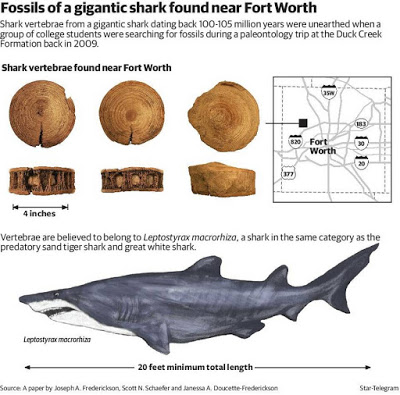 Paleontologists literally stumbled upon fossils just outside Fort Worth that were vertebrae of a monster shark that trolled the shallow seas that covered Texas a hundred millennia ago.
Paleontologists literally stumbled upon fossils just outside Fort Worth that were vertebrae of a monster shark that trolled the shallow seas that covered Texas a hundred millennia ago.
A group of college students was searching for fossils in 2009 during a paleontology trip to the Duck Creek Formation, hoping to bring home some pieces to display.
Walking along a section of the formation with exposed limestone, Joseph Frederickson’s wife, Janessa Doucette-Frederickson, tripped over a boulder and noticed a fossil.
“We dig it out and realize it was a unique fossil,” Joseph Frederickson told the Fort Worth Star-Telegram. “None of us had seen anything of this size before – we ended up digging up three total fossils.”
The fossils are vertebrae that belonged to a shark at least 20 feet long, dating from 100 million to 105 million years ago. In comparison, present-day great white sharks average 15 feet long.
The Duck Creek Formation, home to Cretaceous Period fossils, is just west of Fort Worth and extends all the way to Oklahoma. Frederickson and his wife are now graduate students at the University of Oklahoma.
Last week, the couple and their colleague Scott Schaefer published their findings, “A Gigantic Shark From the Lower Cretaceous Duck Creek Formation of Texas,” in the scientific journal PLOS One.
While the paleontologists were studying the vertebrae, they learned of other large shark fossils found in Kansas dating from the same period. That shark would have been 27 feet long.
“They would have been living alongside each other,” Frederickson said. “The impressive thing about this is that we have this gigantic shark – over 20 feet – that’s as large as the largest documented great white.”
The finding changes the way people view sharks of that era.
“We didn’t even know there were sharks this large that could have been dominant predators,” Frederickson said. ” … These sharks kind of paved the way for other gigantic species.”
Scientists previously thought that Cretaceous sharks were really small.
“Now we know that they weren’t,” he said.
Frederickson, now a doctoral student in ecology and evolutionary biology at OU, is moving the study forward by looking into the ontogeny of the shark – how it developed.
“Was it quick? Or did it live 100 years and do it really slowly?”
Note : The above story is based on materials provided by Fort Worth Star-Telegram, Distributed by Tribune Content Agency, LLC..










